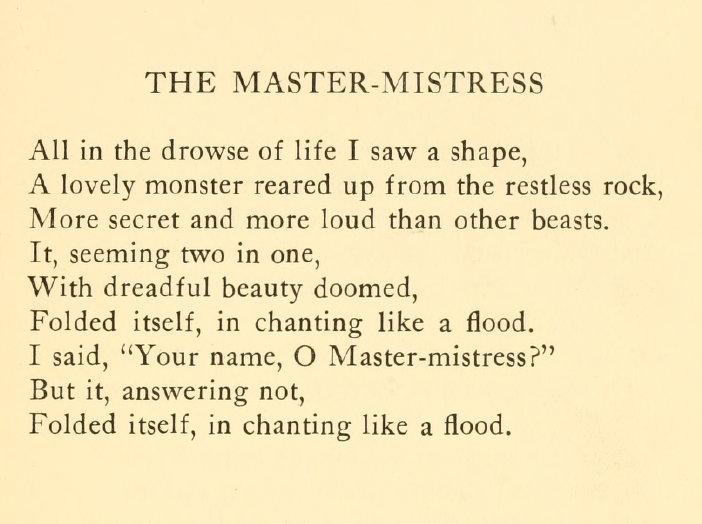Rose O’Neill, The Master-Mistress: Poems
One hundred years ago today … Rose O’Neill, living at 62 Washington Square South, published, had just published, or was about to publish, The Master-Mistress: Poems. The Library of Congress received its copy (which you can view here) on October 11th.
“The Master-Mistress.” O'Neill, Rose Cecil. The Master-mistress: Poems. Frontispiece. Hathitrust.
O'Neill, Rose Cecil. The Master-mistress: Poems. Title page. Hathitrust.
The volume included over two hundred of O’Neill’s poems and nine reproductions of her drawings; the latter had all been exhibited at the Wildenstein Galleries in NYC the previous spring, as we reported in our post for March 8th, 1922.
“The Poetess.” O'Neill, Rose Cecil. The Master-mistress: Poems. P.77. Hathitrust.
The Master-Mistress continued O’Neill’s career drift away from her most popular creations, the Kewpies cartoons, and the merch, the Kewpie Dolls, that had made her, respectively, famous and rich. In her autobiography, she writes: “Now that I had plenty of money I did not illustrate as much but let my hand and imagination have free play” (120).
The title poem exhibits none of the childish playfulness of the Kewpies.
O'Neill, Rose Cecil. The Master-mistress: Poems. P.3. Hathitrust.
This inaugural verse features a “lovely monster” that seems to echo the “rough beast,”and the “terrible beauty” born in fellow Irish poet W.B. Yeats’s apocalyptic “The Second Coming,” published in 1919. That said, O’Neill’s 1922 work expands on the Kewpie universe in that it disrupts gender norms. The entity above, whose name is the the title of the poem and the book, is “seeming two in one”–both lovely and a monster, also both Master and Mistress, male and female.
In a review titled “The Kewpie Woman” for the Tribune, Rex Hunter captured O’Neill’s conundrum. “In the public mind Rose O’Neill is doubtless doomed to be fixed for all time as the kewpie woman…. [T]he appearance of her book “The Master-Mistress” shows that she is not only a graphic artist of great originality and power but also a poet of strange gifts” (New York Tribune, Oct. 29, 1922, p. 56).
The Master-Mistress was put out by Alfred A. Knopf, who would include it in a boastful advertisement for his publishing company: “The poetry I have published this season reaches as high a water mark as a publisher has a right to hope for in a single season…. I published Rose O’Neill’s book of verse and pictures, The Master Mistress” (Advertisement: “History of a Publishing Season,” The New York Times Book Review and Magazine, 8 Oct., 1922, p. 13). Knopf was located at 220 West 42nd Street.
References/ Further reading:
O'Neill, Rose Cecil. The Master-mistress: Poems. New York: A. A. Knopf, 1922.
O'Neill, Rose Cecil. The Story of Rose O’Neill: An Autobiography. Ed. Miriam Formanek-Brunell. Columbia: U of Missouri P, 1997.
– Jonathan Goldman, October 7, 2022.
TAGS: poetry, graphic arts, publishing, cartoons, women writers, sexuality, gender




